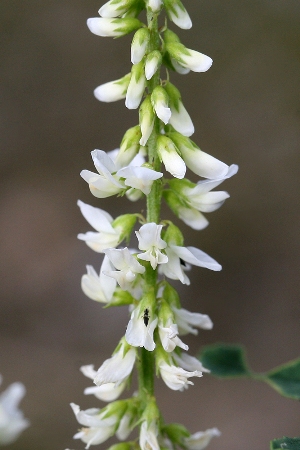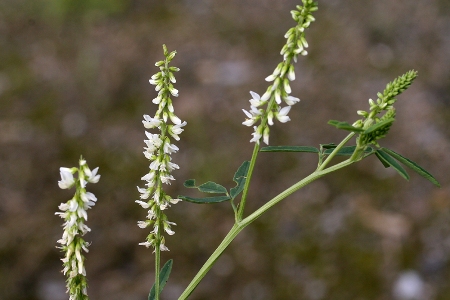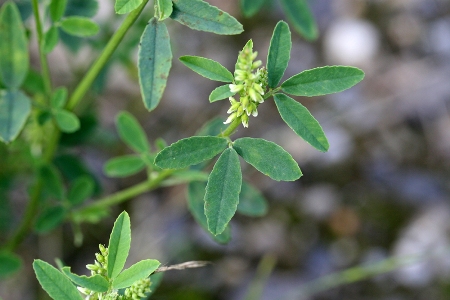Melilotus albus Med. (As.?) – A commonly and widely naturalised alien. Already present in Belgium before 1800 and hence residence status somewhat unclear (although unambiguously taken for a neophyte by Lawalrée 1961). Melilotus albus has a similar distribution pattern as M. officinalis, at least in Flanders (compare in Ronse 2006b). Its largest concentrations are found near the larger cities (especially between Antwerpen and Brussel, furthermore around Brugge, Gent, Kortrijk, Roeselare, etc.). It is obviously much less dispersed in relatively remote and less disturbed parts of Flanders, for instance in Limburg. Contrary to Melilotus officinalis it is still increasing in Flanders.
Melilotus albus is found in a wide range of disturbed habitats: waste land, railway yards, gravel and sand pits, coalmine heaps, canal and river banks, road verges, etc. It usually grows on slightly damp to dry, rather nitrophilous soils.
In the field Melilotus albus is readily distinguished by its white corollas (M. wolgicus is superficially similar but rather unlikely to re-occur, given its origin). However, in the herbarium it is not easily separated from Melilotus officinalis because flower colour rapidly turns whitish in most yellow-flowered species. Lambinon & al. (2004) provides useful characters for the identification of non-flowering plants.
A hybrid with Melilotus officinalis (M. xschoenheitianus Hausskn.) is sometimes produced but apparently not yet recorded from Belgium.
 |
 |
 |
 |
Selected literature:
Faensen-Thiebes A. (1992a) Zur Ökologie von Melilotus alba L. 1. Ökophysiologische Charakteristik des Gaswechsels unter kontrollierten Bedingungen. Flora 186(5/6): 341-357.
Faensen-Thiebes A. (1992b) Zur Ökologie von Melilotus alba L. 2. Ökophysiologische Charakteristik des Gaswechsels unter Freilandbedingungen. Flora 186(5/6): 359-375.
Faensen-Thiebes A. (1992c) Zur Ökologie von Melilotus alba L. 3. Der Lebenszyklus. Flora 186(5/6): 377-391.
Klemow K.M. & Raynall D.J. (1981) Population ecology of Melilogus alba in a limestone quarry. J. Ecol. 69: 33-44.
Lambinon J., Delvosalle L., Duvigneaud J. (avec coll. Geerinck D., Lebeau J., Schumacker R. & Vannerom H. (2004) Nouvelle Flore de la Belgique, du Grand-Duché de Luxembourg, du Nord de la France et des Régions voisines (Ptéridophytes et Spermatophytes). Cinquième édition. Jardin botanique national de Belgique, Meise: CXXX + 1167 p.
Lawalrée A (1961) Papilionaceae. In: Robyns W. (ed.), Flore Générale de Belgique, vol. 4, fasc. 1. Jardin Botanique de l’Etat, Bruxelles: 9-134.
Ronse A. (2006b) Melilotus albus. In: Van Landuyt W., Hoste I., Vanhecke L., Van den Bremt P., Vercruysse W. & De Beer D., Atlas van de flora van Vlaanderen en het Brussels gewest. Instituut voor Natuur- en Bosonderzoek, Nationale Plantentuin van België en Flo.Wer: 583.
Turkington R.A.., Cavers P.B. & Rempel E. (1978) The biology of Canadian weeds: 29. Melilotus alba Desr. and M. officinalis (L. ) Lam. Canad. J. Pl. Sci. 58(2): 523-537. [available online at: http://pubs.aic.ca/doi/pdf/10.4141/cjps78-078]

